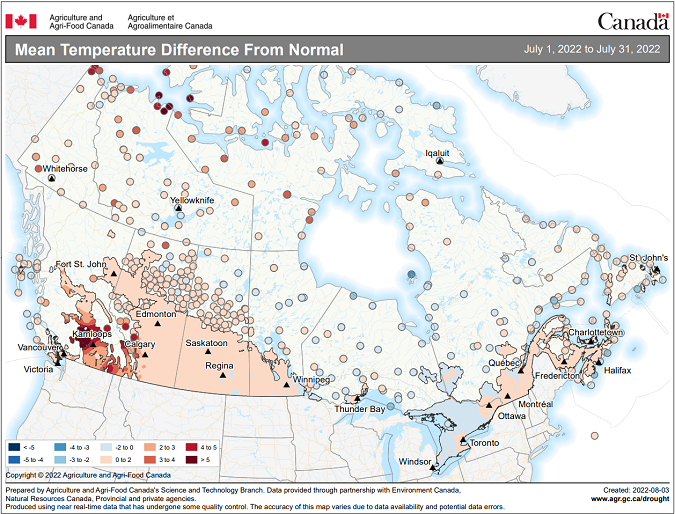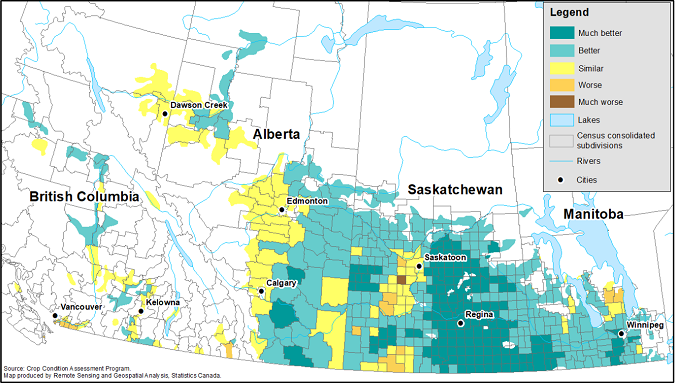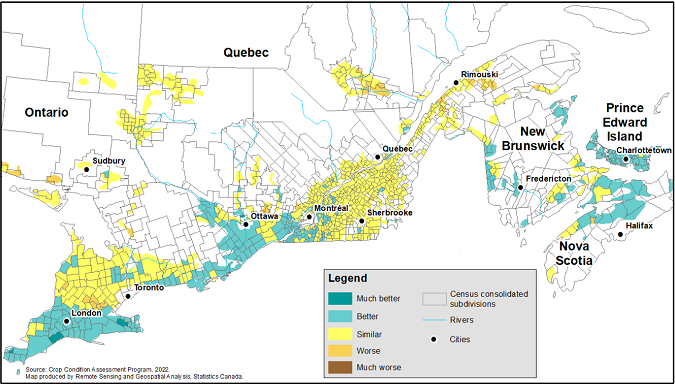
News
Business & Policy
StatsCan: Model-based principal field crop estimates as of July
August 30, 2022 By Statistics Canada
In 2022, Canadian farmers are projected to produce more wheat, canola, barley, oats, soybeans and corn for grain, according to recent yield model estimates using satellite imagery and agroclimatic data. Increased production was largely driven by better growing conditions in Western Canada.
In parts of the Prairies, higher-than-average precipitation and more moderate temperatures have resulted in better crop conditions than in 2021. In Alberta, provincial reports indicated that approximately three-quarters of the total crop were rated as being in good to excellent condition, well above 2021 reports, where only one-fifth of the total crop was rated good to excellent. Reports from the Manitoba government indicated that provincial crop conditions were better than in 2021 and that yields are anticipated to be near normal. Dry conditions continue to be a concern for parts of Saskatchewan, where precipitation remains below average.

Departure from average precipitation (in millimetres) from April 1 to August 1 (during the growing season), by province. Graphics courtesy of Statistics Canada.
In Eastern Canada, much of southern Ontario has experienced drier-than-average conditions, while eastern parts of the province and most of Quebec received higher-than-average rainfall. In general, temperatures over the last month of the growing season were slightly cooler than normal.
For several years, Statistics Canada has relied upon proven satellite technology and agroclimatic data to model preliminary estimates of crop yields and production. These methods have been used successfully to produce September yield estimates since 2016, and they replaced those used to produce July yield estimates in 2020. Coarse resolution-based satellite modelling relies on historical averages for harvested area. Final harvested area estimates will be published on December 2 based on the November 2022 Field Crop Survey.
The Crop Condition Assessment Program indicates that overall plant health in the Prairie provinces was similar to higher-than-normal at the end of July, indicating the possibility of normal to much higher-than-normal yields.

Mean temperature difference from normal (in degrees Celsius) from July 1 to July 31 (during the growing season), by province.
An assessment of Normalized Difference Vegetation Index (NDVI) curves, which are a measure of plant health, indicated that despite a somewhat slower-than-normal start to the growing season, NDVI curves for most areas in Western Canada have exceeded normal NDVI values. In most parts of the Prairies, crops reached peak health in line with normal crop development.
Crop development in Eastern Canada is considered similar to higher-than-normal, as growing conditions have generally been favourable, although lack of moisture in southern Ontario has been a concern for producers.
Wheat production is expected to increase due to higher harvested area and better yields
Nationally, wheat production is projected to increase by 55.1 per cent year over year to 34.6 million tonnes in 2022, largely attributable to higher anticipated yields, which are expected to rise by 41.6 per cent to 51.1 bushels per acre (bu/ac). Harvested area is also expected to increase by 9.4 per cent to 24.9 million acres.
The increase in expected total wheat production is largely attributable to spring wheat, which is anticipated to rise by 57.3 per cent to 25.6 million tonnes. This increase is a result of higher anticipated yields (+39.8 per cent to 52.7 bu/ac) and higher harvested area, expected to increase by 12.5 per cent to 17.8 million acres.

Vegetation growth index as of the week of July 25 to July 31, compared with normal, by census consolidated subdivision for Western Canada.
Durum wheat yields are also anticipated to rise (+101.0 per cent to 40.6 bu/ac), contributing to higher expected durum wheat production (+113.0 per cent to 6.5 million tonnes).
In 2022, wheat yields in Saskatchewan are expected to rise by 55.2 per cent to 43.6 bu/ac, while harvested area is projected to rise by 12.5 per cent, resulting in a 74.4 per cent increase in production, to 15.4 million tonnes.
Wheat production in Alberta is projected to increase by 79.5 per cent to 11.5 million tonnes compared with 2021, which is largely the result of higher yields (+64.4 per cent to 57.2 bu/ac), while harvested area is expected to rise by 9.3 per cent to 7.4 million acres.
In Manitoba, wheat harvested area is expected to rise by 11.4 per cent to 3.2 million acres, while yields are anticipated to increase by 20.5 per cent to 57.7 bu/ac. Total wheat production is anticipated to rise by 34.2 per cent year over year to 5.0 million tonnes.
Wheat production in Ontario (the majority of which is winter wheat) is projected to fall by 22.7 per cent to 2.2 million tonnes year over year as a result of lower harvested acres (-20.6 per cent) and yields (-2.7 per cent).
Higher anticipated yields push canola production higher
Nationally, canola production is expected to rise by 41.7 per cent to 19.5 million tonnes in 2022, as growing conditions in the Prairies improved considerably relative to 2021, pushing yields higher (+47.8 per cent to 40.5 bu/ac).

Vegetation growth index as of the week of July 25 to July 31, compared with normal, by census consolidated subdivision for Eastern Canada.
Canola production in Alberta is expected to increase by 49.1 per cent to 6.5 million tonnes. The projected increase in yields (+53.3 per cent to 44.3 bu/ac) is expected to offset the decrease in harvested area (-2.8 per cent to 6.4 million acres).
In Manitoba, yields are expected to rise by 31.5 per cent to 43.0 bu/ac, offsetting an anticipated 3.8 per cent decrease in harvested area to 3.3 million acres, resulting in an expected 26.5 per cent production increase to 3.2 million tonnes.
Corn for grain production is projected to increase due to higher yields
Nationally, corn for grain production is projected to increase by 6.0 per cent to 14.8 million tonnes in 2022, because yields are anticipated to rise to 163.9 bu/ac (+2.3 per cent), and harvested area is expected to rise to 3.6 million acres (+3.6 per cent).
In Ontario, the largest corn-for-grain-producing province, production is expected to rise by 3.5 per cent to 9.8 million tonnes, due to higher harvested area (+5.0 per cent to 2.2 million acres), offsetting lower yields (-1.5 per cent to 172.6 bu/ac).
Corn for grain production in Quebec is projected to rise by 4.2 per cent to 3.6 million tonnes. Yields are expected to rise by 3.5 per cent to 158.0 bu/ac, while harvested area is expected to increase by 0.6 per cent to 887,400 acres.
Soybean production is expected to rise due to higher yields
Nationally, soybean production is projected to increase by 1.8 per cent year over year to 6.4 million tonnes in 2022. Yields are expected to rise by 3.7 per cent to 45.3 bu/ac, while harvested area is anticipated to decrease by 1.7 per cent to 5.2 million acres.
Soybean production in Ontario is expected to edge up 0.1 per cent in 2022 to 4.1 million tonnes. Harvested area is expected to rise by 5.5 per cent to 3.1 million acres, while yields are anticipated to fall 5.0 per cent to 49.0 bu/ac.
In Manitoba, soybean production is projected to increase by 13.6 per cent to 1.1 million tonnes in 2022. Harvested area is projected to decrease by 14.3 per cent to 1.1 million acres. However, yields are projected to rise by 32.5 per cent year over year to 35.9 bu/ac because moisture conditions have improved.
In Quebec, soybean production is projected to increase by 4.4 per cent to 1.2 million tonnes as a result of higher anticipated yields (+0.5 per cent to 44.4 bu/ac), while harvested area is expected to rise by 3.7 per cent to 950,900 acres.
Barley and oat production is projected to rise
Higher barley yields compared with 2021 (+57.7 per cent to 67.8 bu/ac) are projected to more than offset lower anticipated harvested area (-14.8 per cent to 6.3 million acres). As a result, barley production is expected to rise by 34.3 per cent year over year to 9.3 million tonnes in 2022.
Oat production is projected to rise by 59.2 per cent to 4.5 million tonnes. Harvested area is expected to increase by 10.6 per cent to 3.2 million acres, and yields are expected to rise by 44.1 per cent year over year to 90.2 bu/ac.